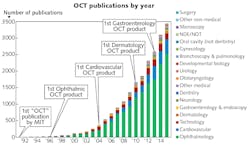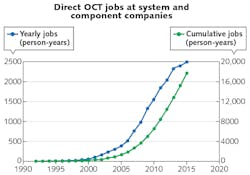Optical Coherence Tomography: Beyond better clinical care - OCT's economic impact

ERIC A. SWANSON
The field of optical coherence tomography (OCT) has grown dramatically since its discovery in the early 1990s. The commercialization and growth of OCT, which has occurred over the past 25 years, has been highly impactful scientifically, clinically, and economically. Many factors have helped drive this success, starting with the clinical need for new cost-effective, high-resolution, minimally invasive imaging solutions for various diagnostic and therapeutic applications. But equally important to this success has been the worldwide ecosystem consisting of the intertwined role of scientists, engineers, clinicians, professional societies, government agencies, government funding, regulatory bodies, entrepreneurs, venture capitalists, and small and large corporate entities within the biomedical optics industry, as well as from other industries.
There are various ways to observe and quantify OCT's impact. In the history of ophthalmology, few imaging technologies have been adopted more quickly than OCT, and OCT is an increasingly important research and clinical tool in cardiology, gastroenterology, and dermatology.
In ophthalmology, about 30 million OCT scans are conducted yearly (one every several seconds)—a frequency commensurate with other major imaging modalities such as positron emission tomography (PET), computed tomography (CT), and magnetic resonance imaging (MRI). According to Jay Wei, founder and CEO of ophthalmic device developer Optovue (Fremont, CA), "The clinical benefit to the patient and the work flow to clinics have been a major impact to society."
Cardiovascular disease is the number-one killer in the world and there are ~100,000 cardiovascular OCT procedures per year, which is helping advance understanding of cardiovascular disease, critical in the development of new devices and interventions, and increasingly being used in everyday clinical decision-making.
OCT is also playing an increasingly important role in understanding and treating several forms of cancer, the number-two leading cause of death.
Returns on investment
Government funding has been key to OCT's progress, and remains critical for the future. Although the technology has potential to advance many more medical specialties, research and development risk has gated commercial momentum in many areas.
Governments around the world have collectively invested more than $500 million in OCT research over the past decade.1 It should be noted that many of the OCT-related government research grants noted1 were not for developing OCT technology, but simply were using OCT in their research. Figure 1 shows the dramatic growth in OCT papers over the past 25 years, along with indications of when some of the commercial clinical products were released-a clear catalyst to an increase in publications.
Revenue from the sale of OCT systems (including biometry) in 2015 is estimated at ~$750 million/year (www.octnews.org), and ~100 companies now supply OCT systems or components. Cumulatively since the 1996 release of the first commercial product, total OCT system revenue (not including components) has likely exceeded ~$5.2 billion.
It is interesting to compare the government investments in OCT research over the past decade to the total tax receipts generated by employment-related taxes, corporate taxes, and other taxes from the commercialization of OCT. Such a comparison is indicative of one aspect of the payback in government-sponsored research.
Of course, there are many other more important aspects of the payback, the most important being the improvement in clinical understanding and clinical care across many medical specialties, resulting in improved quality of life of the millions of people who have had OCT exams and the many more that will occur in the future.
It is challenging to estimate the total tax receipts paid into government coffers by OCT system suppliers directly and indirectly by the employees of the OCT system companies. There are many forms of taxes and many authorized taxing agencies across federal, state, and local governing bodies. For example, U.S. taxes include taxes on: corporate profits, personal income, social security, Medicare/Medicaid, unemployment tax, federal insurance contribution act taxes (FICA), sales tax, excise tax, freight tax, duty/customs tax, and many more.
Using a PricewaterhouseCoopers framework for estimating taxes2 as a guide, direct taxes borne by companies and passthrough taxes collected by the company for corporate and individual income tax receipts from just the OCT system supplier revenue base represent an amount in excess of $500 million. Supply chain taxes and taxes in indirect employment represent additional revenues to the government.
Equally impressive is the massive savings in healthcare expenditures. According to David Huang, MD, Ph.D., of Oregon Health & Science University (Portland, OR), one of the inventors of OCT, "OCT is a big saver of healthcare dollars—the guidance of anti-vascular endothelial growth factor therapy in age-related macular degeneration alone saves billions of dollars per year by avoiding unnecessary injections."3
Beyond the excellent return on taxpayer investment to government coffers from taxes, it is interesting to estimate the number of direct and indirect OCT jobs created by the OCT marketplace.
Quantifying employment impact
To estimate the impact OCT has made on employment, 70 companies involved in selling systems and components were asked to supply their yearly individual historical "OCT-direct" employment statistics, starting with the year they began their OCT efforts. Instructions were to include any OCT-linked job in any discipline (including R&D, engineering, manufacturing, marketing, sales, general, and administrative). Non-disclosure agreements (NDAs) were signed where requested.
Companies focused exclusively on OCT reported 100% of their employment, and multi-product companies were asked to identify employment headcount directly linked to an OCT product.
Sixty-four of the world's leading OCT system and component suppliers responded, representing 90% of the companies contacted, and they are (in alphabetical order): Agfa Healthcare, Alazartech, Avinger, Axsun, Bausch+Lomb/Technolas Perfect Vision, Leica/Bioptigen, Canon, Cambridge Technology, Convai Medical/Colibri, Compact Imaging, Corning, CyLite Optics, DermaLumics, Damae Medical, Diagnostic Photonics, Exalos, Gooch & Housego, Haag Streit, Heidelberg Engineering, Imalux, Innoluce, Innolume GmbH, Insight Photonics, Jenoptik, Keysight Technologies, LLTech, Mabri.Vision, MedLumics, Michelson Diagnostics, Micron Optics, MicroTech, Shenzhen Moptim Imaging Technology, NinePoint Medical, NKT Photonics, Novacam, OCTLight ApS, OCT Medical Imaging, OFS/Furukawa, OPMedT, Optores, Optos, Optovue, Perimeter Medical, PhotoniCare, Physical Sciences Incorporated, Praevium, Santec, Schwind Eye-Tech Solutions, Sensors Unlimited/United Technologies Corp., St. Jude Medical/Abbot, Superlum, Terumo, Thorlabs, Tomey, Tomophase, Topcon, Tornado Spectral Systems, Vivolight, Voxeleron, Wasatch Photonics, WiO Technology Limited, Carl Zeiss Meditec, and two companies that asked to remain anonymous.
Six companies (Abbot/Optimedica, BaySpec, Denselight Semiconductors, Heliotis, Inphenix, and Nidek) declined participation, and no attempt was made to estimate their job-creation impact. Figure 2 shows the results.It is important to note that many other jobs related to the OCT component and subsystem supply chain are not included in this report, and the results in Fig. 2 represent a coarse lower bound on direct yearly employment. For example, each OCT system shipped includes many parts, such as a monitor, computer, chassis, power supplies, optical beam scanners, and fiber-optic components, and including employment data associated with the companies that supply these and other items are not included in our study and could easily represent a doubling or more in the employment number based on an allocation of the cost of goods sold (OCT-centric items vs. more general components and subsystems).
Another major source of employment not included in our results is that associated with medical and support personnel who use the clinical systems installed around the world. It is estimated that well over 50,000 clinical OCT systems have been sold, requiring technicians, photographers, nurses, receptionists, and administrators to operate and support them. Making an assumption that 20% of a staff member's time is required to operate an installed system at a busy clinic implies about 10,000 jobs per year, or ~100,000 additional full-time person-years of employment cumulatively.
Also not included is an estimated ~1000 additional jobs per year associated with the numerous OCT research groups around the world supporting professors, post-docs, students, and related university staff.
In total, we estimate that OCT systems and component companies annually support well over 2500 high-quality jobs directly, and 5–10X that number indirectly. Cumulatively as of 2016, this represents well over 20,000 person-years of employment directly and perhaps over 100,000 person-years indirectly.
Summary
In summary, the OCT system market was ~$750 million/year in 2015 and cumulative revenue over the past 25 years has surpassed ~$5 billion. The total federal government research investment over the past decade was ~$500 million (much of which was for the use of OCT in research not for developing fundamental OCT technology) and the total government tax receipts from OCT system companies and their direct employees was likely in excess of ~$500 million while taxes from indirect employment and component supply chain could far exceed ~5X that number.
This benefit to government tax receipts is in addition to even larger financial savings from more efficient and effective clinical treatments, savings in the billions of dollars, and the improved quality of life for millions of patients that have undergone OCT examinations. The OCT industry has provided a large number of high-quality jobs in direct and indirect employment. There are many other measures of economic impact in addition to those included here related to both product sales and health care efficiencies.
There remain many exciting technology and application frontiers for OCT yet to be developed. On the technology side, there are innovations in hardware, optics, systems, probes, sources, multimodal imaging, surgical guidance, and software. On the application side, only a few of the many medical fields shown in Fig. 1 have been commercialized and many remaining fields have total available markets in excess of $1 billion. Government funding for basic OCT research and applications remains critical to developing new technology and medical and non-medical applications. Hopefully, the OCT industry will continue to grow in its scientific, clinical, and economic impact-benefitting individual patients, workers, and overall economies for years to come.
ACKNOWLEDGEMENT
The author would like to thank the 64 companies that supplied employment data and those that also provided market-size data. If any companies serving the OCT market are not included here but are willing to provide employment data confidentially, please contact www.octnews.com, as there will be an update to this publication in the not-too-distant future.
REFERENCES
1. E. Swanson, "One decade and $500M: The impact of federal funding on OCT," BioOptics World (Sept/Oct. 2011); see http://bit.ly/1UF3O7n.
2. See http://www.pwc.com/us/en/national-economic-statistics/publications/how-much-tax-companies-pay.html.
3. D. Huang et al., to be published.
Editor's note: An earlier version of this article first appeared in OCT News.
